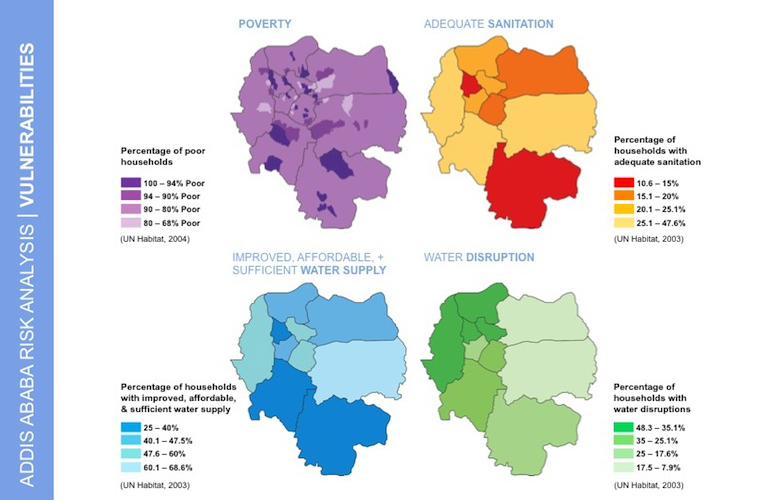
Addis Ababa, the capital city of Ethiopia, is home to the African Union and the UN Economic Commission for Africa, as well as the second highest percentage of population living in slums (85–90%) among African cities. Addis Ababa’s location at the foot of Mount Entoto and its position 9° north of the equator alters the climate to produce relatively mild temperatures. The city is served by a number of rivers, mainly the Big and Little Akaki Rivers and the Awash River, which run through the dense urban core (ethiopia.gov, n.d.). With the population growing at a rate of 3.8% annually, the city is expected to contain 8 million residents by 2020 (csa.gov.et, n.d.). As a result, the built up areas are projected to expand into undeveloped zones on the periphery, decreasing green space.
Performing a climate risk assessment (Mehrotra et al., 2009) shows that several climate change hazards will affect Addis Ababa. Average temperature is expected to increase (McSweeney, New, & Lizcano, 2008), causing increased and prolonged heat waves (Capuano, Sellerino, Di Ruoco, Kombe, & Yeshitela, 2013). However, these hazards will not prove as dangerous to the city as other hazards because of its mild baseline temperatures. Increased drought is not projected for Addis but will be a problem for surrounding regions (Capuano et al., 2013), causing an influx of people migrating into the city, leading to more impermeable surfaces and thus increasedwater runoff. The increase of intense rainfalls in the city (McSweeney et al., 2008) will contribute to more frequent flooding of the city’s extensive waterway network. This will endanger residents by compromising their water supply.
Beyond the external environmental hazards, Addis is vulnerable due to its poor social and physical infrastructure systems, such as overcrowding and improper waste disposal. The lack of housing infrastructure makes living hard for inhabitants. Most of the water resources for everyday living come from the city’s rivers, which are impacted by point and nonpoint sources of pollution. Due to the poor waste disposal infrastructure and the inaccessibility of public toilets, inhabitants are forced to turn to these rivers for sanitation services.
Addis Ababa is addressing its environmental infrastructure constraints through its environmental, housing, and water authorities; but the city lacks resources and the ability to effectively coordinate stakeholders (USUAP II, 2011). Through the 2011 Urban Sanitation Universal Access Plan II, the 2002 Wastewater Master Plan, the modernization of two water purification plants, and the building of a dam to increase water flow into the city, the Addis Ababa Water & Sewerage Authority aims to improve water and sanitation conditions (Tadele, 2013).
To address adaptation to climate change the city must augment current efforts with additional policies to create a more complete response to the climate risk outlined above. A change in city zoning laws to allow green spaces along all waterways is recommended to improve water quality and increase resistance to floods. Taking additional steps to impose penalties on industries polluting the rivers and to reallocate more of the city’s budget to the water and sewerage authority will also help Addis Ababa increase climate resilience.
This article is a product of Professor Shagun Mehrotra’s Climate Change and Cities class. Views expressed are entirely those of the authors.
References
Addis Ababa City Council – Ethiopian government portal Retrieved 10/1/2013, 2013, from http://www.ethiopia.gov.et/stateaddisababa
Capuano, P., Sellerino, M., Di Ruocco, A., Kombe, W., & Yeshitela, K. (2013). Climate change induced heat wave hazard in eastern africa: Dar es salaam (tanzania) and addis ababa (ethiopia) case study. EGU General Assembly Conference Abstracts, 15 3366.
Central Statistical Agency – 2012 POPULATION.pdf Retrieved 10/1/2013, 2013, from http://http://www.csa.gov.et/images/documents/pdf_files/nationalstatisticsabstract/2012/2012%20POPULATION.pdf
Federal Democratic Republic of Ethiopia. (2011). Urban Sanitation Universal Access Plan II. Retrieved 11/4/2013 from http://www2.gtz.de/Dokumente/oe44/ecosan/en-wastewater-masterplan-2002.pdf
McSweeney, C., New, M., & Lizcano, G. (2008). UNDP climate change country Profiles–Ethiopia. Profiles for 52 Countries.
Mehrotra, S., C.E. Natenzon, A. Omojola, R. Folorunsho, J. Gilbride & C. Rosenzweig. (2009). Framework for city climate risk assessment. Washington, DC: World Bank.